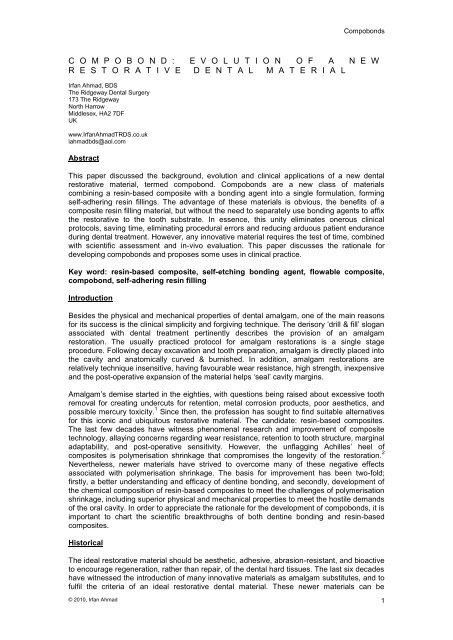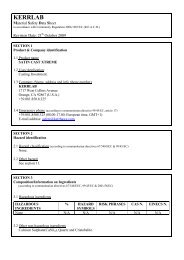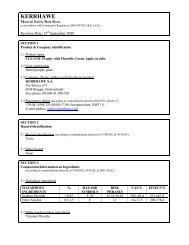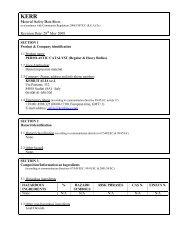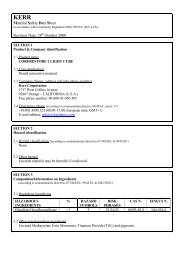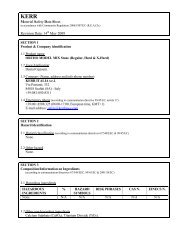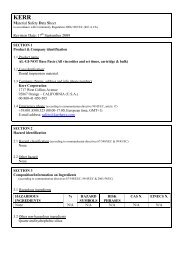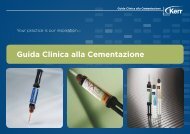Vertise Flow-Dr Irfan Ahmad - Kerr
Vertise Flow-Dr Irfan Ahmad - Kerr
Vertise Flow-Dr Irfan Ahmad - Kerr
You also want an ePaper? Increase the reach of your titles
YUMPU automatically turns print PDFs into web optimized ePapers that Google loves.
Compobonds<br />
C O M P O B O N D : E V O L U T I O N O F A N E W<br />
R E S T O R A T I V E D E N T A L M A T E R I A L<br />
<strong>Irfan</strong> <strong>Ahmad</strong>, BDS<br />
The Ridgeway Dental Surgery<br />
173 The Ridgeway<br />
North Harrow<br />
Middlesex, HA2 7DF<br />
UK<br />
www.<strong>Irfan</strong><strong>Ahmad</strong>TRDS.co.uk<br />
iahmadbds@aol.com<br />
Abstract<br />
This paper discussed the background, evolution and clinical applications of a new dental<br />
restorative material, termed compobond. Compobonds are a new class of materials<br />
combining a resin-based composite with a bonding agent into a single formulation, forming<br />
self-adhering resin fillings. The advantage of these materials is obvious, the benefits of a<br />
composite resin filling material, but without the need to separately use bonding agents to affix<br />
the restorative to the tooth substrate. In essence, this unity eliminates onerous clinical<br />
protocols, saving time, eliminating procedural errors and reducing arduous patient endurance<br />
during dental treatment. However, any innovative material requires the test of time, combined<br />
with scientific assessment and in-vivo evaluation. This paper discusses the rationale for<br />
developing compobonds and proposes some uses in clinical practice.<br />
Key word: resin-based composite, self-etching bonding agent, flowable composite,<br />
compobond, self-adhering resin filling<br />
Introduction<br />
Besides the physical and mechanical properties of dental amalgam, one of the main reasons<br />
for its success is the clinical simplicity and forgiving technique. The derisory ‘drill & fill’ slogan<br />
associated with dental treatment pertinently describes the provision of an amalgam<br />
restoration. The usually practiced protocol for amalgam restorations is a single stage<br />
procedure. Following decay excavation and tooth preparation, amalgam is directly placed into<br />
the cavity and anatomically curved & burnished. In addition, amalgam restorations are<br />
relatively technique insensitive, having favourable wear resistance, high strength, inexpensive<br />
and the post-operative expansion of the material helps ‘seal’ cavity margins.<br />
Amalgam’s demise started in the eighties, with questions being raised about excessive tooth<br />
removal for creating undercuts for retention, metal corrosion products, poor aesthetics, and<br />
possible mercury toxicity. 1 Since then, the profession has sought to find suitable alternatives<br />
for this iconic and ubiquitous restorative material. The candidate: resin-based composites.<br />
The last few decades have witness phenomenal research and improvement of composite<br />
technology, allaying concerns regarding wear resistance, retention to tooth structure, marginal<br />
adaptability, and post-operative sensitivity. However, the unflagging Achilles’ heel of<br />
composites is polymerisation shrinkage that compromises the longevity of the restoration. 2<br />
Nevertheless, newer materials have strived to overcome many of these negative effects<br />
associated with polymerisation shrinkage. The basis for improvement has been two-fold;<br />
firstly, a better understanding and efficacy of dentine bonding, and secondly, development of<br />
the chemical composition of resin-based composites to meet the challenges of polymerisation<br />
shrinkage, including superior physical and mechanical properties to meet the hostile demands<br />
of the oral cavity. In order to appreciate the rationale for the development of compobonds, it is<br />
important to chart the scientific breakthroughs of both dentine bonding and resin-based<br />
composites.<br />
Historical<br />
The ideal restorative material should be aesthetic, adhesive, abrasion-resistant, and bioactive<br />
to encourage regeneration, rather than repair, of the dental hard tissues. The last six decades<br />
have witnessed the introduction of many innovative materials as amalgam substitutes, and to<br />
fulfil the criteria of an ideal restorative dental material. These newer materials can be<br />
© 2010, <strong>Irfan</strong> <strong>Ahmad</strong> 1
Compobonds<br />
categorised as resins and glass-ionomers with numerous hybrids, consisting of combinations<br />
of both materials. Resins yield a superior bond to enamel, but a less predictable bond to<br />
dentine. 3 Conversely, glass-ionomers bond better to dentine by offering true chemical<br />
adhesion and releasing fluoride for bioactivity, but have inferior mechanical properties<br />
compared to resins. Numerous cross bread materials such as resin modified glass ionomers,<br />
compomers, and giomers have strived to exploit the beneficial properties of both materials<br />
with varying degrees of success. For example, in 2001 giomers were introduced,<br />
incorporating a pre-reacted glass (PRG) filler to facilitate fluoride release from a resin-based<br />
composite. 4<br />
Other classes of materials include siloranes and ormocers. Whilst the silorane-based<br />
composites have the lowest polymerisation shrinkage of any resin, they display mixed<br />
mechanical properties; flexural strength and modulus of elasticity (MOE) are higher, but their<br />
compressive strength & microhardness is lower compared to metacrylate-based composites. 5<br />
Orcemer technology is another addition to the dental restorative armamentarium, having<br />
excellent wear resistance, but poor polishability. The evolution of compobonds, launched in<br />
2009, is based on the premise of promising clinical outcomes of dentine bonding agents<br />
(DBA) and resin-based composites.<br />
Dentine Bonding Agents (DBA)<br />
The acid-etch technique, introduced by Buonocore in 1955, was seminal and opened the<br />
doors to the possibilities of achieving a bond to natural tooth substrates with artificial acrylicbased<br />
restoratives. 6 Whilst bonding to enamel has changed little since its inception more than<br />
half a century ago, bonding to dentine has proved far more elusive, undergoing enormous<br />
changes. A major advancement for achieving a sustainable bond to dentine was the<br />
introduction of the total-etch (TE) technique 7 in the late seventies (Fig. 1).<br />
The first self-etching primer, combining an etchant and primer into a single step, was<br />
introduced in the early nineties. 8 The self-etching primers not only simplified bonding to<br />
dentine, but also eliminated the clinical errors associated with this exacting procedure. The<br />
result was a more predicable dentine bond and longevity of a composite resin filling. The next<br />
decade witnessed many formulations, including etchant+primer followed by adhesive, etchant<br />
followed by primer+adhesive, and more recently in the mid-noughties, combining all three<br />
constituents, etchant+primer+adhesive, into a single component and a one step procedure<br />
(Fig. 2).<br />
Contemporary dentine bonding agents can be divided into two varieties, either the total-etch<br />
(TE) or the self-etch (SE). To complicate matters further, the TE bonding systems are<br />
available as either three or two-step systems, while SE as either two or one-step systems,<br />
which are available as one, two or three bottles components. Therefore to resolve some of<br />
these dilemmas for choosing a DBA, simplifying clinical techniques and minimising errors, the<br />
current trend is moving away from multi-component and multi-step bonding systems. 9 Also,<br />
encouragingly, both TE and SE varieties have bond strengths to dentine that are comparable<br />
to that of enamel, i.e. approximately 22 MPa. 10<br />
The salient difference between the TE and SE agents is as that an initial etching stage is<br />
required with the former, but unnecessary with the latter. For TE, both enamel and dentine<br />
are simultaneously etched, usually with phosphoric acid, and followed by application of the<br />
primer and adhesive, or both components together in a single liquid. With the SE agents,<br />
precursory etching is superfluous, since this is concurrently performed together with the<br />
primer and adhesive.<br />
Although SE agents expedite the bonding procedure, the major difference between TE and<br />
SE bonding agents is concerning the smear layer. With TE agents, the etching and drying of<br />
dentine is susceptible to clinical errors. This is because the inorganic phase of dentine is<br />
dissolved, leaving the organic collagen matrix unsupported. If this organic matrix is not rehydrated<br />
by the primer and adhesive, the dentine bond is severely compromised. In order to<br />
ensure that the collagen fibres are hydrated necessities leaving the dentine moist, which is<br />
difficult to assess clinically. Alternately, the DBA should contain a solvent to re-hydrate the<br />
collagen fibres, e.g. water or ethanol, in order that the adhesive can impregnate the spaces<br />
© 2010, <strong>Irfan</strong> <strong>Ahmad</strong> 2
Compobonds<br />
once occupied by the inorganic phase, and form a resin-collage complex, or the hybrid layer.<br />
DBAs containing the solvent acetone are particularly vulnerable desiccated dentine, since<br />
acetone evaporates rapidly leaving collapsed collagen fibres. 11 Therefore, if the adhesive<br />
bonding technique is incorrectly executed, the dentine bond is inferior causing poor adhesion,<br />
marginal leakage & discolouration and post-operative sensitivity. One of the reasons for postoperative<br />
sensitivity is inadequate sealing of the dentine tubules following etching during the<br />
dentine bonding procedure. 12 The latter is due to inadequate clinical protocols cited above,<br />
and particularly plagues TE, multi-step bonding agents. After the etching phase, the dentine<br />
tubules are exposed and at risk after removal of the inorganic matrix plus the smear layer. If<br />
the next two stages, priming and introduction of the adhesive, are incompetently performed to<br />
seal the tubules by formation of an adequate hybrid layer, post-operative sensitivity is an<br />
inevitable symptom. On the other hand, SE DBAs dissolve, rather than removing the smear<br />
layer, which is incorporated within the collagen fibres and the resin monomer to form a viable<br />
hybrid layer. Therefore, the reduced post-operative sensitivity reported by some studies with<br />
SE agents could be attributed to incorporation of the smear layer into the hybrid layer, and<br />
therefore never leaving the exposed dentine tubules in a precarious situation. 13 Other studies<br />
have reported no difference in dentine hypersensitivity using either the TE or SE systems,<br />
and poor clinical technique has quoted mentioned as the most significant factor, rather than<br />
the type of DBA, for mitigating post-operative symptoms. 14<br />
To summarise, the advantages of SE systems are:<br />
1. Less technique sensitive<br />
2. Degree of dentine moisture not a concern<br />
3. Depth of etching and adhesive penetration are similar since both processes occur<br />
simultaneously<br />
One of the drawbacks of the SE systems highlighted by some studies is the relatively high pH<br />
≈ 2, compared to traditional phosphoric acid with a pH ≈ 1, resulting in inferior bond strengths<br />
1516<br />
compared to TE systems. However, other studies have failed to find significant<br />
differences between the two systems, 17 and current research is inconclusive and ambivalent.<br />
The SE agents are divided into strong or mild groups, the former having a pH of 1, and the<br />
latter pH of 2, respectively. Although the milder versions are less aggressive and form thinner<br />
hybrid layers, a thinner hybridisation zone does not appear to compromise bond strength. 18 It<br />
is the integrity (absence of voids, tears), rather than the thickness of the hybrid layer which<br />
seems more significant to a viable dentine bond. Another possible drawback with the onestep<br />
SE agents is residual water that may remain in the dentine tubules, thereby leading to<br />
incomplete polymerisation of the adhesive, and ultimately compromising retention. 19 However,<br />
SE are innovate products in their infancy, and further in-vivo medium and long-term trials are<br />
necessary to validate these concerns.<br />
Having achieved the 7 th generation of SE bonding agents, the 8 th and future generations of<br />
DBAs should incorporate ingredients for regenerating natural hard tissues, rather than limiting<br />
their functions to adhesion. The properties of these new, so called, biomaterials, should<br />
include antibacterial, bioactive and biofunctional performance.<br />
Resin-based composites<br />
The number of resin-based composites on the market is both impressive and overwhelming.<br />
Composite technology revolution over the last few decades has resulted in many novel<br />
products, and choosing the correct material for a specific clinical scenario is both daunting<br />
and perplexing. Unfortunately, revolution has let to confusion. The following generic<br />
classification categorises cotemporary resin-based composites, together with their properties<br />
and uses:<br />
1. Hybrids – Universal or general purpose. Low wear resistance, long term increase in<br />
surface roughness, e.g. posterior restorations, Class I, II<br />
2. Micro-filled – More aesthetic than hybrids, retain surface polish/lustre over time, e.g.<br />
Class III, IV, V. Highly filled (loaded) variants for extreme occlusal loads, e.g. Class I,<br />
II<br />
© 2010, <strong>Irfan</strong> <strong>Ahmad</strong> 3
Compobonds<br />
3. Nano-filled – Similar to micro-filled, most aesthetic. Aesthetically demanding regions<br />
of the mouth, high polishability, excellent optical properties (opalescence,<br />
fluorescence), e.g. Class III, IV, direct composite laminate veneers<br />
4. Micro- and nano-hybrid varieties. Universal or general purpose<br />
5. <strong>Flow</strong>ables – low viscosity, low MOE, low filler content. Suited for areas of low occlusal<br />
loads due to poor wear resistance, low strength and increase polymerisation<br />
shrinkage. However, due to the reduced filler content, polymerisation stress is also<br />
lower. Ideal for small pits and fissures not exposed to occlusal loads, primary<br />
dentition restorations, blocking undercuts for indirect prostheses (e.g. inlays, crowns)<br />
and stress-relieving liners for deep Class I, II, V large cavities, preferably fluoride<br />
releasing varieties, e.g. giomer.<br />
Ideally, composites should possess similar physical, mechanical and optical properties as the<br />
natural hard tissues they are replacing. Therefore, for highly aesthetic restorations, where<br />
appearance and optical issues are of paramount concern, the ideal choice is a micro- or<br />
nanofilled composite. However, the later are unsuitable for high stress bearing posterior<br />
restorations due to poor wear characteristics, and in these circumstances a prudent choice is<br />
a universal composite, e.g. a hybrid or micro- or nano-hybrid.<br />
Whilst resin-based composites have revolutionised restorative dentistry, they are not without<br />
their problems. The main reason for failure of composite fillings is marginal breakdown and<br />
secondary caries 20 . However, it is not a fait accompli that secondary carious lesions will<br />
ensue in the presence of an open or discoloured cavosurface margin. The current thinking is<br />
that patient risk factors such as oral hygiene, dietary considerations and the attitude towards<br />
dental treatment, are pivotal in determining whether decay will follow. 21<br />
As previously stated, marginal breakdown is attributed to polymerisation shrinkage of a<br />
composite during its setting stage, ranging from 2% to 5% 22 by volume, causing stresses that<br />
lead to bonding failure and gap formation (Figs. 3 & 4). Polymerisation stresses can be<br />
mitigated by the clinical technique, modulus of elasticity (MOE) of the material and cavity<br />
configuration or “C’ factor. In an effort to circumvent polymerisation shrinkage, manufacturers<br />
have altered the chemical composition of composites to confer favourable properties. These<br />
include varying the size, shape and volume of the inorganic filler particles, as well as<br />
improving adhesion of the fillers to the organic resin matrix. Other factors that reduce stresses<br />
are the method of setting reaction, e.g. using pulse curing, 23 and incremental build-up of the<br />
composite filling during placement. 24 Another technique (discussed below) is using flowables,<br />
with a lower MOE, as the initial base-lining layer to absorb polymerisation stresses and<br />
counteract forces at the restoration-dentine interface. 25<br />
<strong>Flow</strong>ables<br />
<strong>Flow</strong>able composites, introduced nearly two decades ago, have become ubiquitous for many<br />
applications. <strong>Flow</strong>ables display greater fluidity & elasticity, offering better adaptation to<br />
internal cavity walls and are very user friendly. In addition, the radiopacity of these resins<br />
allows effortless detection of secondary caries, and revealing marginal integrity or open<br />
margins. A restorative material should possess radiopacity that is slightly greater than enamel<br />
to distinguish decay, 26 and greater than the ISO minimum standard of equal or greater to an<br />
equivalent thickness of aluminium. This is especially significant if flowables are used as intracoronal<br />
initial lining layers below subsequent increments of universal composite. The ISO<br />
standard for minimum flexural strength (FS) for outer occlusal restorative materials is 80MPa,<br />
which is displayed by most of the current flowables on the market. The FS depends on the<br />
specific proprietary material, ranging from 70 MPa to approximately 100MPa, deteriorating<br />
over time, and is about 80% compared to nonflowables analogues. Although microleakage is<br />
a multifactorial phenomenon, MOE of the material is a crucial factor that determines its<br />
magnitude. Similar to FS, MOE shows is variable depending on the product, ranging from 3<br />
GPa to over 11 GPa, and also decreasing over time. The viscoelastic properties of a flowable<br />
determine its flowability and clinical handling. The flow characteristics of flowable campsites<br />
can be divided into low, medium and high flow. 27 Each variety is suitable for different clinical<br />
tasks. For example, a highly flowable material is desirable as a liner or fissure sealant, to<br />
intimately adapt to cavity walls or fissures crevices, respectively, while a less flowable variety<br />
is preferable for small cavities or repairs, where excessive slumping is a nuisance.<br />
© 2010, <strong>Irfan</strong> <strong>Ahmad</strong> 4
Compobonds<br />
Currently, most of the flowable composites possess little bacterial inhibitory potential,<br />
especially against Streptococcus mutans, the main infective agent of dental caries. Whilst a<br />
few flowables on the market claim anti-bacterial activity, the effect is usually ephemeral,<br />
effective for only a few days. 28 Future composite developments should endeavour to<br />
incorporate both antibacterial and bioactivity in their formulations for enhanced therapeutic<br />
value.<br />
In conclusion, flowables are useful for areas of reduced occlusal stresses, and<br />
contraindicated for bulk build-ups in stress bearing areas. Their popularity is due to ease of<br />
use and flexible adaptability, especially in areas of limited access. The clinical applications<br />
include fissure sealing, small cavities, base liners, repairing voids in defective restorations<br />
and blocking undercuts for subsequent indirect prostheses.<br />
Evolution of a new resin-based restorative: Compobonds<br />
As discussed above, the state-of-the-art of dentine bonding systems are the SE agents that<br />
obviate the need to perform an initial etching phase, while yielding bond strengths that are<br />
comparable to bonding to enamel. Also, the pinnacle of resin-based composites technology is<br />
the introduction of nano- and nano-hybrid composites. The advancements in both bonding<br />
agents and resins have now evolved by uniting these two materials to produce a new dental<br />
restorative: the compobonds. Compobonds exploit the benefits of SE DBAs and nanofilled<br />
resins, eliminating the precursory bonding stage necessary to adhere a resin to tooth<br />
substrate, and are termed self-adhering composites. In essence, an era is emerging when<br />
composites, similar to amalgam fillings, can be placed in a single step, eliminating errors,<br />
expatiating protocols, and improving predictability and longevity of restorations.<br />
The first compobond was introduced in 2009 called <strong>Vertise</strong> <strong>Flow</strong> (<strong>Kerr</strong> Corp., USA), a selfadhering<br />
flowable combining a resin-based composite and a SE bonding agent based on the<br />
7 th generation DBA, OptiBond ® All-in-One (<strong>Kerr</strong> Corp., USA). <strong>Vertise</strong> <strong>Flow</strong> is a light-cured<br />
composite with similar properties to conventional flowables but with the added advantage of<br />
eliminating the bonding stage that is prerequisite before using any resin-based restorative<br />
(Fig. 5).<br />
Characteristics and properties of <strong>Vertise</strong> <strong>Flow</strong><br />
<strong>Vertise</strong> TM <strong>Flow</strong> incorporates the properties of the DBA, OptiBond ® , the first filled bonding<br />
agent introduced in 1992 (Fig. 6), that realised the potential of using a filled adhesive as a<br />
shock absorber beneath resin-based composite restorations. The bonding mechanism of<br />
OptiBond ® to dentine is two-fold. Firstly, chemical adhesion is realised by the phosphate<br />
function group of the GPDM monomer (glycerol phosphate dimetharcylate) uniting with the<br />
calcium ions within the tooth, and secondly, micromechanical adhesion by formation of the<br />
hybrid layer composed of resin impregnation with the collagen fibres and the dentine smear<br />
layer. Initial SEMs and TEMs from the University of Leuven, Belgium show tight adaptation of<br />
<strong>Vertise</strong> TM <strong>Flow</strong> to both dentine and enamel. In addition, microleakage tests show that<br />
<strong>Vertise</strong> TM <strong>Flow</strong>’s marginal integrity is comparable to other SE bonding agent in conjunction<br />
with non-adhering conventional flowable composites. 29<br />
The shear bond strength (SBS) achievable with <strong>Vertise</strong> TM <strong>Flow</strong> and dentine is approximately<br />
25 MPa, comparable to bonding to cut, prismatic enamel. However, the SBS is lower with<br />
uncut or aprismatic enamel, which is similar to using SE agents alone. For this reason, it is<br />
advisable to either bevel, or etch aprismatic enamel beforehand to ensure a sustainable and<br />
durable marginal seal (Fig. 7). Conversely, pre-etching dentine when using <strong>Vertise</strong> TM <strong>Flow</strong><br />
reduces the SBS to dentine, and is therefore contraindicated. Another disadvantage of preetching<br />
dentine is opening dentine tubules that may not be sealed to the same depth by the<br />
subsequent use of <strong>Vertise</strong> TM <strong>Flow</strong>, and could contribute to post-operative sensitivity.<br />
The chemical composition of <strong>Vertise</strong> TM <strong>Flow</strong> incorporates four types of fillers, with a total of<br />
70% loading. The inclusion of nano-ytterbium fluoride confers excellent radiopacity & fluoride<br />
release [for bioactivity], the pre-polymerised fillers reduce microleakage, and nanoparticles<br />
improve polishability & thixotropic properties. The flexural strenght is 120 MPa for mitigating<br />
© 2010, <strong>Irfan</strong> <strong>Ahmad</strong> 5
Compobonds<br />
bulk fracture, and a low Modulus of Elasticity of around 7GPa for shock absorbing capability<br />
(Fig. 8).<br />
Because <strong>Vertise</strong> TM <strong>Flow</strong> is functioning as both a dentine adhesive and a resin restorative<br />
material, a longer curing time is necessary to ensure that both constituents are fully<br />
polymerised. In addition, the light curing reaction also halts the etching process of the SE<br />
agent, increasing its pH from approximately 2 to 7, so that continual acidity does not erode<br />
the dentine bond.<br />
A further advantage of <strong>Vertise</strong> TM <strong>Flow</strong> is inclusion of the acidic phosphate monomer, which<br />
provides chemical adhesion to a variety of intaglio surfaces of indirect prostheses, including<br />
non-precious alloys, gold, alumina, zirconia and silica ceramics, e.g. feldspathic, lithium<br />
disilicate or other pressed ceramic systems. This adhesive property is exceptionally useful for<br />
repairing intra-oral fractured porcelain, e.g. all-ceramic crowns, inlays or onlays, or patching<br />
up chipped porcelain defects without replacing the entire prosthesis (Fig. 9).<br />
The handling properties of <strong>Vertise</strong> TM <strong>Flow</strong> are favourable for numerous applications. For<br />
example, its viscosity occupies a middle ground, neither too viscous nor too runny, and<br />
therefore satisfies a wider range of clinical applications, i.e. as a liner/sealant, as well as for<br />
entire small cavity restorations. <strong>Vertise</strong> TM <strong>Flow</strong> is available in a selection of shades for<br />
discerning aesthetic demands, ranging from XL for bleached teeth to Translucent for fissure<br />
sealing that allows visibility of any future decay (Fig. 10).<br />
Similar to glass-ionomers and their variations, compobonds offer adhesion to natural tooth<br />
substrate. However, whilst both materials have similar indications, their properties and<br />
handling characteristics vary considerably. Glass-ionomers essentially adhere exclusively to<br />
dentine, have low mechanical strength, average aesthetics, low wear resistance but offer both<br />
fluoride release and recharge. In addition, the setting reaction is affected by the degree of<br />
moisture of dentine, and involves a two stage clinical procedure. On the other hand,<br />
compobonds offer dentine & enamel bonding, high strength, low wear, better aesthetics, a<br />
single stage clinical procedure and fluoride release, but not fluoride recharge.<br />
Clinical applications of <strong>Vertise</strong> TM <strong>Flow</strong><br />
The clinical uses of <strong>Vertise</strong> TM <strong>Flow</strong> are not unlike those of conventional flowables, but with the<br />
added advantage of eliminating the bonding stage. Below are some suggested applications.<br />
Fissure sealing<br />
One of the fundamental treatments for preventative dentistry is fissure sealing posterior<br />
permanent teeth soon after their eruption into the oral cavity. Traditionally, this has been<br />
achieved solely with enamel etching, relying on micromechanical retention, and depending on<br />
diet, the fissure sealants require periodic replacement or repair. Using <strong>Vertise</strong> TM <strong>Flow</strong> instead<br />
of conventional fissure sealants offers not only micromechanical retention, but also chemical<br />
adhesion to the enamel via the SE agent that links with the calcium ions from the<br />
hydroxyapetite matrix.<br />
The following case study depicts fissure sealing a first permanent molar tooth in a child of 14<br />
years of age. Ideally the tooth should be isolated with rubber dam to ensure moisture control<br />
and a clear operating field (Fig. 1). Initially, the tooth is air abraded with aluminium oxide<br />
powder to clean the pits and fissures, remove the plaque biofilm, superficial incipient decay,<br />
and if present, remnants of old fissure sealants (Fig. 2). The cleansing is continued with slurry<br />
of pumice to eliminate residues of the aluminium powder (Figs. 3 & 4). After rinsing the<br />
pumice (Fig. 5), 37% phosphoric acid is dispensed to etch the pits and fissures (Fig. 6) and<br />
surrounding uncut, aprismatic enamel (Fig. 7). The classic frosty etched enamel appearance<br />
is clearly visible after rinsing off the etchant and drying the occlusal surface (Fig. 8).<br />
Since <strong>Vertise</strong> TM <strong>Flow</strong> should be refrigerated to ensure extended shelf life and optimal<br />
performance, it is advisable to remove it beforehand to so that the material reaches room<br />
temperature. A translucent shade of <strong>Vertise</strong> TM <strong>Flow</strong> is copiously dispensed (Figs. 10 & 11))<br />
and brushed onto the enamel to ensure intimate contact with its surface, and spread to a thin<br />
© 2010, <strong>Irfan</strong> <strong>Ahmad</strong> 6
Compobonds<br />
layer of less than 0.5 mm (Figs. 11 & 12). The coated surface(s) are light cured with a curing<br />
light having an output of 800 MW/cm 2 for 20 seconds (Fig. 13). The rubber dam is then<br />
removed and articulation paper placed to check occlusal contacts (Fig. 14). All the articulation<br />
paper marks, except those on the supporting buccal cusps (palatal cusps for maxillary teeth),<br />
are adjusted and polished with Opti1Step Polishers (<strong>Kerr</strong>Hawe SA, Switzerland) - Fig. 15 &<br />
16.<br />
Small, non-stress bearing, non-contacting cavities<br />
Small cavities in areas of minimum occlusal stress are ideal candidates for minimally invasive,<br />
microdentistry. Incipient carious lesions can be either monitored if the patient risk factors are<br />
low, or may require intervention for patients with a propensity for dental decay. The case<br />
study presented below is of a 13 years old girl who is an occasional attendee, and relatively<br />
indifferent to dental treatment. The pre-operative status shows the maxillary second pre-molar<br />
and first molar with occlusal cavitations, and an old defective composite occlusal restoration<br />
in the molar (Fig. 1). Cavity preparation is carried out using small diamond burs specifically<br />
designed to minimise removal of excessive tooth substrate (Fig. 2). Current research shows<br />
that it is unnecessary to remove all decayed dentine. Instead, the cavity margins are clearly<br />
defined for creating a hermetic seal for guarding against the negative effects of the dental<br />
biofilm, which perpetually colonises the tooth surface. 30 As previously mentioned, in order to<br />
improve bond strength to aprismatic enamel, the margins can be either etched, or bevelled<br />
(Fig. 3). The initial layer of <strong>Vertise</strong> TM <strong>Flow</strong> should be less than 0.5 mm thickness, and pressed<br />
into the recesses of the cavity floor & walls (Fig. 4 & 5). The initial layer of <strong>Vertise</strong> TM <strong>Flow</strong> is<br />
first light-cured (Fig. 6), before completing the cavity with additional layers. Finally, the<br />
restoration is polished with Opti1Step Polishers and OptiShine brush (<strong>Kerr</strong>Hawe SA,<br />
Switzerland) to yield a high lustre gloss (Fig. 7).<br />
Class V cavities<br />
Class V cavities have variable presentations. The exposed dentine in Class V cavities can be<br />
the result of enamel loss due to erosion, abrasion abfraction or infectious caries. The dentine<br />
reaction is highly erratic, often leading to formation of hypermineralized sclerotic dentine that<br />
is resistant and less receptive to dentine adhesion. 31 Therefore, in the presence of sclerotic<br />
dentine, all DBAs are less efficacious and present a challenge for dentine bonding. For this<br />
reason, <strong>Vertise</strong> TM <strong>Flow</strong> is unsuitable for Class V lesions with blatant dentine hypermineralized<br />
sclerotic dentine. If sclerotic dentine is absent, dentine adhesion with bonding agents is<br />
superior (28 MPa), compared to a compomer (15 MPa) or a glass-ionomer (2.5 MPa). 32 In the<br />
following case study, a freshly prepared buccal cavity without traces of sclerotic dentine was<br />
restored with <strong>Vertise</strong> TM <strong>Flow</strong>. Pre-operative articulation paper marks were created to verify<br />
that the buccal lesion was free of occlusal, stress-bearing contacts (Fig. 1). After placing the<br />
rubber dam, the tooth was cleaned with slurry of pumice (Fig. 2), and a cavity was prepared<br />
with bevelled enamel margins (Fig. 3). The final result shows restoration of the cavity with A3<br />
<strong>Vertise</strong> TM <strong>Flow</strong> after polishing with Opti1Step Polishers (<strong>Kerr</strong>Hawe SA, Switzerland) – Fig. 4.<br />
Stress-relieving linings<br />
The rationale for using different composites for various increments of a restoration is that the<br />
materials should possess similar properties to the natural dentine and enamel they are<br />
replacing. Dentine has a lower MOE, and is therefore better suited for absorbing stresses<br />
than enamel. For this reason, in circumstances when the cavity extends into dentine, the<br />
initial layer of composite should have shock absorbing capabilities that are similar to dentine.<br />
OptiBond ® (<strong>Kerr</strong> Corp, USA) was the first filled bonding agent introduced in 1992 that acted<br />
as a shock absorber underneath resin-based composite restorations.<br />
The polymerisation contraction stresses of a resin-based composite is directly related to its<br />
filler volume, which also affects its mechanical properties such as wear resistance and<br />
modulus of elasticity (MOE). High filler content results in less contraction, which in turn<br />
influences the marginal integrity of the restoration. 33 <strong>Flow</strong>ables have approximately 25% less<br />
filler than their nonflowable counterparts and therefore undergo increased volumetric<br />
shrinkage, However, since flowables have about 50% less MOE than nonflowables, they can<br />
absorb more stresses, and in theory, maintain superior marginal integrity. 34 The MOE of a<br />
© 2010, <strong>Irfan</strong> <strong>Ahmad</strong> 7
Compobonds<br />
flowable ranges from as low as 1.4 GPa (low filler volume) to as high as 12.5GPa (high filler<br />
content). 35 In addition to filler content, other constituents such as the type and quantity of<br />
resin, photoinitiators and accelerators also influence the final MOE of the material. As a<br />
generalization, flowables with a lower MOE may act as shock absorbers when placed as precured<br />
liners below subsequent increments of nonflowables. But current studies are<br />
inconclusive regarding this beneficial property, 36 37 and further research is necessary to clarify<br />
the issue.<br />
In the following case study, large Class I cavities in two mandibular molars were restored<br />
using <strong>Vertise</strong> TM <strong>Flow</strong> as an initial layer to act as a shock absorber, before completing the<br />
restoration with subsequent layers of a nonflowable composite. This case study shows the<br />
second and third mandibular molars with defective amalgam restorations requiring<br />
replacement. In addition, these teeth also exhibit bruxist activity with tooth wear resulting in<br />
occlusal enamel loss. Initial occlusal contacts were verified (Fig. 1) before placing a rubber<br />
dam, and removing the amalgam restorations. Notice the extensive decay in third molar (Fig.<br />
2). Since molars are prone to high occlusal forces, placing bevels on enamel margins is<br />
unsuitable because the thin slice of composite resin periphery is likely to fracture during<br />
mastication. However, to achieve an efficacious bond to aprismatic enamel, it is prudent to<br />
etch the periphery while maintaining a 90º cavo-surface angle (Fig. 3). After thoroughly rinsing<br />
and drying, the etched enamel periphery of both cavities is clearly visible (Fig. 4 & 5).<br />
<strong>Vertise</strong> TM <strong>Flow</strong> is dispensed into the cavity, brushed to ensure that the material is evenly<br />
spread on the cavity walls and floor, and making sure that its thickness does not exceed 0.5<br />
mm (Figs. 6 to 8). This initial layer of <strong>Vertise</strong> TM <strong>Flow</strong> is light cured for 20 seconds, and acts as<br />
the stress relieving lining (Fig. 9). Subsequent layers of the filling are built-up using<br />
increments of a regular composite, Herculite ® XRV Ultra TM (<strong>Kerr</strong> Corp, USA), to replace<br />
dentine, and then successively building-up the buccal and lingual cups 38 separately without<br />
contacting the opposing sides (Fig. 10).<br />
Staining fissures is a contentious issue; some patients are indifferent to this practice, while<br />
others adamantly refuse to have stained teeth. For those patients who are unconcerned,<br />
fissure staining and patterns imparts a realistic appearance to a composite filling. The<br />
technique involves using different stains, e.g. Kolor + Plus ® (<strong>Kerr</strong> Corp, USA), that are<br />
dragged through the un-set composite resin using an endodontic reamer or file (Figs. 11 &<br />
12). Once the desired fissure pattern is created, the composite is light cured (Figs. 13 & 14).<br />
After removing the rubber dam, articulation paper is used to check occlusal contacts (Fig. 15),<br />
and necessary adjustments made to ensure occlusal harmony. The final stage is achieving a<br />
high surface lustre and texture using Opti1Step Polishers (<strong>Kerr</strong>Hawe SA, Switzerland). The<br />
post-operative view shows composite fillings emulating natural cusps and fissure patterns,<br />
with imperceptible transition between the composite filing and surrounding enamel (Fig. 16).<br />
Blocking undercuts<br />
Another useful application of a flowable is blocking out undesirable undercuts prior to<br />
providing indirect restorations. Undercuts often complicate many clinical and laboratory<br />
procedures, e.g. impression making or restoration fabrication, respectively. Unwanted sharp<br />
line angles or deficiencies, such as voids, can readily be blocked and sealed with the easily<br />
adaptable flowable composites for both intra- and extra-coronal tooth preparations.<br />
In the following case study a large amalgam restoration, with underlying profound decay, was<br />
scheduled for an indirect ceramic inlay. After isolation with rubber dam, the amalgam filling<br />
from the maxillary molar was removed revealing gross carious dentine (Fig. 1). All soft,<br />
carious dentine was exacted leaving blatant undercuts (Fig. 2). Due diligence was exercised<br />
not to remove all the hard, deeper decayed dentine to avoid possible pulpal exposure. In this<br />
instance, <strong>Vertise</strong> TM <strong>Flow</strong> has a dual function, firstly to block undercuts, and secondly to act as<br />
a stress absorbing liner for the subsequent indirect ceramic inlay (Fig. 3).<br />
Repairing<br />
Lastly, <strong>Vertise</strong> TM <strong>Flow</strong> can be used for minor repairs, for either chairside or laboratory made<br />
acrylic based temporary restorations, such as crowns with air blows or chips or fractures after<br />
© 2010, <strong>Irfan</strong> <strong>Ahmad</strong> 8
Compobonds<br />
a period of use in the mouth. Once again, the repair protocol is simplified and predictable,<br />
involving a single step, with the added benefit of the SE bonding agent within <strong>Vertise</strong> TM <strong>Flow</strong>.<br />
Another form of repair involves the increasingly problematic fractures associated with ceramic<br />
prostheses such as crowns or inlays. Since these types of all-ceramic indirect restorations are<br />
increasingly popular, the number of fractures is also becoming progressively more common,<br />
and replacement is costly and often clinically embarrassing. Traditionally, ceramic fracture<br />
repair involved several stages, i.e. etching with hydrofluoric acid, silination, and repairing with<br />
conventional resin-based composites, either a flowable or nonflowable variety. As previously<br />
mentioned, <strong>Vertise</strong> TM <strong>Flow</strong> incorporates an acidic phosphate monomer, which chemically links<br />
to many ceramic substrates such as silica, alumina and zirconia. Therefore, after roughening<br />
the fracture ‘lesion’ with a diamond bur, only a single step is necessary with <strong>Vertise</strong> TM <strong>Flow</strong><br />
that combines both chemical bonding and a repairing composite to ‘heal’ the fracture. The<br />
following case study illustrates repair of a fractured, alumina core crown, veneered with silica<br />
(feldspathic) porcelain. The patient presents with a distal fracture of the all-ceramic crown on<br />
the maxillary left central incisor (Fig. 1). A shade analysis was performed with Vita Classic<br />
shade guide (Vita, Germany), and <strong>Vertise</strong> TM <strong>Flow</strong> A2 was chosen for the body of the crown,<br />
and a Translucent shade for the incisal edge translucency (Fig. 2). Initial cleansing was<br />
carried out with slurry of pumice to remove the plaque biofilm (Fig. 3).<br />
To increase the surface area for bonding, the fractured porcelain requires pre-treatment<br />
roughening, which can be achieved either mechanically or chemically. The choice is mainly<br />
empirical, depending on the clinician’s personal experience and penchant for either<br />
technique. Mechanical roughening involves using a rotary instrument followed by cleansing<br />
the site with phosphoric acid (Fig. 4), which does not etch porcelain, but removes any<br />
remaining debris. The chemical method involves etching the porcelain with hydrofluoric acid<br />
for 3 minutes. It is important to note that only silica based ceramics can be etched with<br />
hydrofluoric acid, and if the fracture extends deeper into an alumina or zirconia substructure,<br />
the latter will require mechanical roughening with a diamond bur. Customarily, the next stage<br />
is application of hydrofluoric acid and silane for creating a silica-silane bond. However, this is<br />
superfluous using <strong>Vertise</strong> TM <strong>Flow</strong> as the later incorporates an acidic phosphate monomer that<br />
bonds to silica, as well as alumina and zirconia ceramics. An A2 shade of <strong>Vertise</strong> TM <strong>Flow</strong> is<br />
dispensed directly onto the etched fracture site (Fig. 6), and spread intimately ensuring firm<br />
contact with the porcelain (Fig. 7). In order to mimic the incisal edge translucency, a<br />
Translucent shade of <strong>Vertise</strong> TM <strong>Flow</strong> is used at the incisal edge (Fig. 8), and slightly overbuilt<br />
to compensate for the polishing stage (Fig. 9). Finishing and polishing is carried out using<br />
sequentially finer grit discs (OptiDisc ® , <strong>Kerr</strong>Hawe SA, Switzerland) – Fig. 10, creating a<br />
surface roughness (Ra) of approximately 0.2 μm, equal to or less than the threshold required<br />
for bacterial and plaque adhesion (Ra = 0.2 μm). 39 The post-operative result shows the<br />
polished repair harmoniously blending with the surrounding porcelain (Fig. 11).<br />
Similar to porcelain repairs, existing chipped or marginally stained composites (both direct<br />
and indirect restorations), can be effortlessly repaired. The protocol is minimally invasive,<br />
economical, expedient, and also spares the patient protracted appointments to replace the<br />
entire restoration, which can instead be monitored at periodic recalls.<br />
Conclusion<br />
This article has introduced the evolution of a new dental restorative material, the<br />
compobonds. The discussion has focussed on the rationale for development of compobonds,<br />
citing technological advances in both dentine bonding agents & resin-based composite<br />
formulations. In addition, a proprietary product, <strong>Vertise</strong> TM <strong>Flow</strong> is described as the first<br />
generation of flowable compobonds with clinical applications similar to existing flowable<br />
composites, and some novel uses such as direct intra-oral porcelain fracture repairs. The<br />
benefits of combining a SE dentine bonding agent with a composite-resin eliminates the<br />
technique sensitive protocols associated with dentine bonding, making the entire process<br />
simpler and more predictable. However, as with any new material, scientific scrutiny and<br />
clinical trails will untimely judge the efficacy of compobonds, and if successful, will pave the<br />
way for nonflowable varieties to simplify direct composite restorations.<br />
© 2010, <strong>Irfan</strong> <strong>Ahmad</strong> 9
Compobonds<br />
Figures<br />
Fig. 1 – TE (total-etch) dentine bonding agents involve<br />
etching (red) both enamel and dentine followed by the<br />
primer (yellow) and adhesive (green).<br />
Fig. 2 – SE (self-etch) dentine bonding agents combine<br />
the etchant, primer and adhesive into a single formation<br />
and a one-step clinical procedure.<br />
Fig. 3 – One of the limitations of composite fillings is<br />
polymerisation shrinkage, leading to marginal<br />
breakdown.<br />
Fig. 4 – Polymerisation shrinkage of resin-based<br />
composites results in marginal staining.<br />
Fig. 5 – <strong>Vertise</strong> TM <strong>Flow</strong> is a self-adhering flowable<br />
composite, combining a self-etching bonding agent with<br />
a resin-based composite.<br />
Fig. 6 – The bonding agent in <strong>Vertise</strong> TM <strong>Flow</strong> is based on<br />
the technological advances of OptiBond ® , the first filled<br />
dentine-bonding agent introduced in 1992, which has<br />
now evolved into a self-etching system.<br />
Fig. 7 – When using <strong>Vertise</strong> TM <strong>Flow</strong>, it is advisable to<br />
either bevel, or etch aprismatic enamel of the cavity<br />
margins.<br />
Fig. 8 – <strong>Vertise</strong> TM <strong>Flow</strong> is an excellent base lining, acting<br />
as a shock absorber due to its low modulus of elasticity.<br />
© 2010, <strong>Irfan</strong> <strong>Ahmad</strong> 10
Compobonds<br />
Fig. 9 – <strong>Vertise</strong> TM <strong>Flow</strong> is ideal for intra-oral repairs of<br />
fractured porcelain.<br />
Fig. 10 – The translucent shade of <strong>Vertise</strong> TM <strong>Flow</strong> is<br />
invaluable for detecting future decay underneath fissure<br />
sealed teeth.<br />
Fissure sealing<br />
Fig. 1 – The lower first permanent molar is isolated with<br />
rubber dam using a SoftClamp TM (<strong>Kerr</strong>Hawe SA,<br />
Switzerland). Notice the remnants of an old fissure<br />
sealant resin within the fissures.<br />
Fig. 2 – The tooth is air abraded with aluminium oxide<br />
powder to remove plaque and decay, including remnants<br />
of old fissure sealants.<br />
Fig. 3 – A prophylaxis brush is used to clean the tooth<br />
with slurry of pumice.<br />
Fig. 4 – The pumice removes residues of the aluminium<br />
oxide power.<br />
Fig. 5 – The rinsed tooth following cleaning with pumice.<br />
Fig. 6 – Etchant is dispensed into the fissures and …<br />
© 2010, <strong>Irfan</strong> <strong>Ahmad</strong> 11
Compobonds<br />
Fig. 7 – … continued to the surrounding uncut,<br />
aprismatic enamel.<br />
Fig. 8 – The classical frosty appearance of etched<br />
enamel is clearly evident (compare with Fig. 2)<br />
Fig. 9 – <strong>Vertise</strong> TM <strong>Flow</strong> is dispensed into the fissures...<br />
Fig. 10 – … and then to the entire occlusal surface.<br />
Fig. 11 – A brush is used to press <strong>Vertise</strong> TM <strong>Flow</strong> onto<br />
the enamel surface for 15-20 seconds …<br />
Fig. 12 – …and to obtain a layer of < 0.5 mm thickness.<br />
Fig. 13 – The set <strong>Vertise</strong> TM <strong>Flow</strong> after appropriate light<br />
curing.<br />
Fig. 14 – Articulation paper is used to verify occlusal<br />
contacts. Notice extraneous flash material at the distal<br />
aspect of the permanent molar.<br />
Fig. 15 – For mandibular teeth, all occlusal contacts are<br />
removed, except those on the buccal supporting cusps.<br />
Notice that the distal flash material has been removed.<br />
Fig. 16 – The post-operative view showing sealed<br />
fissures and the high lustre obtained after polishing with<br />
Opti1Step Polishers (compare with Fig. 1).<br />
© 2010, <strong>Irfan</strong> <strong>Ahmad</strong> 12
Compobonds<br />
Small Class I cavity<br />
Fig. 1 – Pre-op view showing cavitation in the occlusal<br />
surfaces of a maxillary molar and pre-molar. The molar<br />
also requires replacement of an occlusal defective<br />
composite filling.<br />
Fig. 2 - Cavity preparation using micro-diamond burs for<br />
minimising excessive tooth removal.<br />
Fig. 3 – All aprismatic enamel margins are carefully<br />
bevelled.<br />
Fig. 4 – The initial layer of <strong>Vertise</strong> TM <strong>Flow</strong> should be<br />
Compobonds<br />
Small buccal cavity<br />
Fig. 1 – Pre-operative occlusal contacts to verify that<br />
cavity is not in a stress bearing area.<br />
Fig. 2 – After rubber dam isolation, pumice is used to<br />
cleanse the tooth.<br />
Fig. 3 – A cavity is prepared with bevelled enamel<br />
margins.<br />
Fig. 4 – Post-operative view showing the cavity restored<br />
with A3 <strong>Vertise</strong> TM <strong>Flow</strong>.<br />
Stress-relieving linings<br />
Fig. 1 – Pre-op view showing defective amalgam fillings<br />
in two mandibular molars. Pre-operative occlusal<br />
contacts are identified before placing the rubber dam.<br />
Fig. 2 – The old amalgam restorations are removed.<br />
Fig. 3 – After removing soft decayed dentine, the enamel<br />
margins are finished with a 90º cavo-surface angle and<br />
etched with phosphoric acid for 15 seconds.<br />
Fig. 4 – The etched enamel peripheries are clearly<br />
visible on the second mandibular molar.<br />
© 2010, <strong>Irfan</strong> <strong>Ahmad</strong> 14
Compobonds<br />
Fig. 5 – The etched enamel peripheries are clearly<br />
visible on the third mandibular molar.<br />
Fig. 6 – <strong>Vertise</strong> TM <strong>Flow</strong> is dispensed into the cavity.<br />
Fig. 7 – A brush is used to spread the <strong>Vertise</strong> TM <strong>Flow</strong><br />
against the cavity walls and…<br />
Fig. 8 – …floor, ensuing that it is evenly spread with a<br />
thickness less than 0.5 mm.<br />
Fig. 9 – The initial <strong>Vertise</strong> TM <strong>Flow</strong> lining is light cured.<br />
Fig. 10 – A regular composite, Herculite ® XRV Ultra TM , is<br />
used in increments for replacing dentine and building up<br />
individual buccal and lingual cups.<br />
Fig. 11 – An endodontic file, loaded with brown Kolor +<br />
Plus ® stain is dragged through the un-set composite<br />
resin to create fissure patterns in the second molar<br />
restoration.<br />
Fig. 12 – An endodontic file, loaded with brown Kolor +<br />
Plus ® stain is dragged through the un-set composite<br />
resin to create fissure patterns in the third molar<br />
restoration.<br />
© 2010, <strong>Irfan</strong> <strong>Ahmad</strong> 15
Compobonds<br />
Fig. 13 – Once the fissure patterns are established, the<br />
composite is light cured in the second molar.<br />
Fig. 14 – Once the fissure patterns are established, the<br />
composite is light cured in the third molar.<br />
Fig. 15 – After removing the rubber dam, occlusal<br />
contacts are checked using articulation paper.<br />
Fig. 16 – The filling is polished to a high lustre with<br />
Opti1Step Polishers, ensuring an indiscernible transition<br />
between the composite filling and surrounding natural<br />
tooth.<br />
Blocking undercuts<br />
Fig. 1 – Underlying decay is clearing evident after<br />
removing an old amalgam filling from the maxillary molar.<br />
Fig. 2 – Undercuts are evident following excavation of<br />
soft, carious dentine.<br />
Fig. 3 – <strong>Vertise</strong> TM <strong>Flow</strong> is used to block the undercuts<br />
and act as a stress relieving lining.<br />
© 2010, <strong>Irfan</strong> <strong>Ahmad</strong> 16
Compobonds<br />
Repairing fractured porcelain<br />
Fig. 1 – Pre-operative view showing a distal fracture of<br />
the all-ceramic crown on the maxillary left central incisor.<br />
Fig. 2 – Shade analysis to ascertain colour of existing<br />
crown. <strong>Vertise</strong> TM <strong>Flow</strong> A2, and translucent shades were<br />
selected to repair the fractured porcelain.<br />
Fig. 3 – Pumice is used to cleanse the crown and<br />
remove any plaque biofilm.<br />
Fig. 4 – The porcelain surface is mechanically<br />
roughened with a diamond bur and then cleansed with<br />
phosphoric acid.<br />
Fig. 5 – Prepared porcelain site<br />
Fig. 6 – An A2 shade of <strong>Vertise</strong> TM <strong>Flow</strong> is dispensed onto<br />
the site.<br />
Fig. 7 – A brush is used to spread the <strong>Vertise</strong> TM <strong>Flow</strong> to<br />
cover the fracture site.<br />
Fig. 8 – A translucent shade of <strong>Vertise</strong> TM <strong>Flow</strong> is used to<br />
build the incisal edge.<br />
© 2010, <strong>Irfan</strong> <strong>Ahmad</strong> 17
Compobonds<br />
Fig. 9 – Palatal view showing the overbuilt repair before<br />
polishing.<br />
Fig. 10 – Polishing is carried out with various grits of<br />
OptiDisc ® to create a high lustre.<br />
Fig. 11 – Post-operative view showing the ‘invisible’<br />
repair, with a smooth texture and high lustre, impeccably<br />
blending with the surrounding porcelain.<br />
© 2010, <strong>Irfan</strong> <strong>Ahmad</strong> 18
Compobonds<br />
1 Jokstad A, Mjor IA. Analysis of long-term clinical behaviour of Class II amalgam restorations. Acta<br />
Odontol Scand 1991;49(1):47-63<br />
2 Condon JR, Ferracane JL. Assessing the effect of composite formulation on polymerisation stress.<br />
JADA 2000;131:497-503<br />
3 Matis, BA, Cochran MJ, Carlson TJ, Guba C, Eckert GJ. A three-year clinical evaluation of two<br />
dentine bonding agents. JADA 2004;135:451-457<br />
4 Teranaka T, Okada S, Hanaoka K. Diffusion of fluoride ion from giomer products into dentine.<br />
Presented at the 2 nd giomer International Meeting;July 1, 2001;Tokyo<br />
5 Lein W, Vandewalle KS. Physical properties of a new silorane-based restorative system. Dent Mater<br />
2010;Jan 4 [Epub ahead of print]<br />
6 Buonocore MG. A simple method of increasing the adhesion of acrylic filling materials to enamel<br />
surfaces. J Dent Res 1955;34:849-53<br />
7 Fusayama T, Nakamura M, Kurosaki N, Iwaku M. Non-pressure adhesion of a new adhesive<br />
restorative resin. J Dent Res 1979;58:1364-70<br />
8 Watanabe I, Nakabayashi N, Pashley DH. Bonding to ground dentine by a phenyl-P self-etching<br />
primer. J Dent Res 1994;73:1212-20<br />
9 Haller B. Recent development in dentine bonding. Am J Dent 2000;13:44-50<br />
10 Hickel R, Manhart J, Garcia-Godoy F. Clinical results and new developments of direct posterior<br />
restorations. Am J Dent 2000;13(supplement):41D-54D<br />
11 <strong>Ahmad</strong> I. Protocols for predictable aesthetic dental restorations. 2006, Blackwell Munksgaard,<br />
Oxford, UK<br />
12 Brannstorm M. Etiology of dentine hypersensitivity. Proc Finn Dent Soc 1992;88(supplement 1):7-<br />
13<br />
13 Gordan VV, Vargas MA, Denehy GE. Interfacial ultrastructure of the resin-enamel region of three<br />
adhesive systems. Am J Dent 1998;11(1):13-6<br />
14 Perdigao J, Geraldeli S, Hodges JE. Total-etch versus self-etch adhesive. Effect on postoperative<br />
sensitivity. JADA 2003;134:1621-1629<br />
15 Pashley DH, Tay FR. Aggressiveness of contemporary self-etching adhesives, part II: etching on<br />
unground enamel. Dent Mater 2001;17:430-44<br />
16 Miyazaki M, Sato M, Onose H. Durability of enamel bond strength of simplified bonding systems.<br />
Oper Dent 2000;25:75-80<br />
17 Perdigao J, Lopes L, Lambrechts P, Leitao J, van Meerbeek B, Vanherle G. Effects of a self-etching<br />
primer on enamel shear bond strengths and SEM morphology. Am J Dent 1997;10:141-6<br />
18 Inoue S, Vargas MA, Abe Y et al. Microtensile bond strength of eleven modern adhesives to dentine.<br />
J Adhes dent 2001;3:237-45<br />
19 Tay FR, Pashley DH, Suhn BI, Carvalho RM, Itthagarun A. Single-step adhesives are permeable<br />
membranes. J Dent 2002;30:371-82<br />
20 Kohler B, Rasmusson CG, Odman P. A five year clinical evaluation of Class II composite resin<br />
restorations. J Dent 2000;28(2):111-6<br />
21 Kidd EA, Joyston-Bechal S, Beighton D. Marginal ditching and staining as a predictor of secondary<br />
caries around amalgam restorations: a clinical and microbiological study. J Dent Res 1995;74(5):1206-<br />
11<br />
22 Cox CF. Microleakage related to restorative procedures. Proc Finn Dent Soc<br />
1992;88(supplement):83-93<br />
23 Kanca J 3 rd , Suh BI. Pulse activation: reducing resin-based composite contraction stresses at the<br />
cavosurface margins. Am J dent 1999;1(3):107-12<br />
24 Liebenburg, WH. The axial bevel technique: a new technique for extensive posterior resin composite<br />
restorations. Quintessence Int 2000;31:231-9<br />
25 Belli S, Inokoshi S, Ozer F, Pereira PN, Ogata M, Tagami J. The effect of additional enamel etching<br />
and flowable composite to the interfacial integrity of Class II adhesive restorations. Oper Dent<br />
2001;26(1):70-5<br />
26 Espelid I, Tveit AB, Erickson RL, Keck SC, Glasspoole EA. Radiopacity of restorations and<br />
detection of secondary caries. Dent Mater 1991;7(2):114-7<br />
27 Moon PC, Tabassian MS, Culbreath TE. <strong>Flow</strong> characteristics and film thickness of flowable resin<br />
composites. Oper Dent 2002;27(3):284-53<br />
28 Matalon S, Weiss EI, Gorfil C, Noy D, Slutzky H. In vitro antibacterial evaluation of flowable<br />
restorative materials. Quintessence Int 2009;40(4):327-32<br />
29 <strong>Kerr</strong> Corp R&D data. October, 2009<br />
© 2010, <strong>Irfan</strong> <strong>Ahmad</strong> 19
Compobonds<br />
30 Kidd EAM, Fejerskov O. What constitutes dental caries? Histopathology of carious enamel and<br />
dentine related to the action of cariogenic biofilms. J Dent Res, 2004;83(Spec Iss C):C35-C38<br />
31 Takahashi A, Inoue S, Kawamoto C, et al. In vivo long-term durability of the bond to dentine using<br />
two adhesive systems. J Adhes Dent 2002;4(2):151-9<br />
32 Xie H, Zhang F, Wu Y, Chen C, Liu W. Dentine bond strength and microleakage of flowable<br />
composite, compomer and glass ionomer. Aust Dent J 2008;53(4):325-31<br />
33 Munksgaard EC, Hansen EK, Kato H. Wall-to-wall polymerisation contraction of composite resin<br />
versus filler content. Scan J Dent Res 1987;95:526-31<br />
34 Fruits TJ, VanBrunt CK, Khajotia SS, Duncanson Jr. MG. effect of cyclic lateral forces on<br />
microleakage in cervical resin composite restorations. Quintessence Int 2002;33:205-12<br />
35 Sabbagh J, Vreven J, Leloup G. Dynamic and static moduli of elasticity of resin-bases materials.<br />
Dent Mater 2002;18:64-71<br />
36 Leevailoj C, Cochran MA, Matis BA, Moore BK, Platt JA. Microleakage of posterior packable resin<br />
composites with and without flowable liners. Oper Dent 2001;26:302-7<br />
37 Jain P, Belcher M. Microleakage of Class II resin-based composite restorations with flowable<br />
composite in the proximal box. Am J Dent 200;13:235-8<br />
38 Liebenberg WH. Successive cusp build-up: an improved placement technique for posterior direct<br />
resin restorations. J Can Dent Assoc 1996;62:501-7<br />
39 Ono M, Nikaido T, Ikeda M, Imai S, Hanada N, Tagami J, Matin K. Surface properties of resin<br />
composite materials relative to biofilm formation. Dent Mater J. 2007 Sep;26(5):613-22<br />
© 2010, <strong>Irfan</strong> <strong>Ahmad</strong> 20


